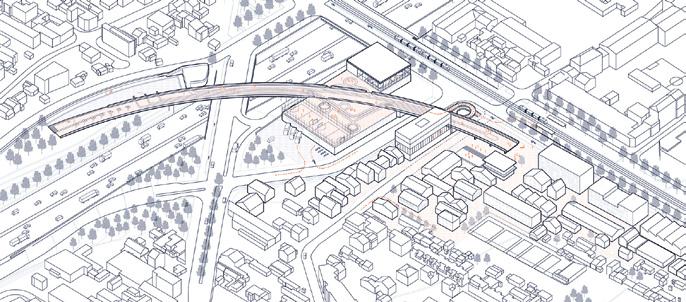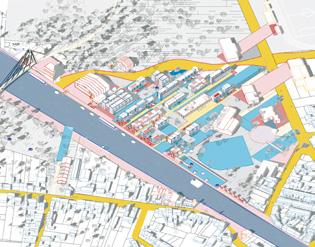
10 minute read
Connectors and Enablers Blaž Babnik Romaniuk (SI), Architect
Connectors and Enablers
Analysis article by Blaž Babnik Romaniuk (SI) — Architect, founder of the office Obrat www.obratdoo.si
Advertisement
TOPIC AS A TOOL There is a substantial diversity in the sites that are grouped together by the similarity of the assignments to meet the demands (and opportunities) of the topic of “Productive Cities”. The sites could find themselves also in other groups of sites, as their conditions are often fundamentally different and could be approached in various ways. The logic behind the grouping could also be seen as a starting point for an open-ended creative process and how the results could be later understood and implemented. Therefore, the topic functions as a tool for generating solutions and interpreting them. The teams of E15 used the sub-theme of “Interfaces and Short Cycles” in a myriad ways, often incorporating or pivoting the themes of “changing metabolism” and “implanting”. Nevertheless, it is important to obtain an insight in to how interfaces, as concepts of spatial development, could engender more complex solutions and proposals. As the sites are highly intertwined realities of social, spatial, administrative and ecological forces, so are the multifaceted and layered concepts of possible futures proposed by Europan 15.
SITE AS A SNAPSHOT Many mutual characteristics of the seven sites could be recognized, however it would be counterproductive to group them according to a degree of similarity, as the complexity could be lost. What could serve as an insight, trying to understand the applicability of proposals in different context or in changed circumstances, is the
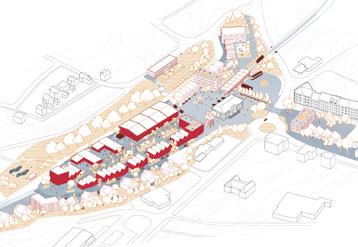

3 — SELB (DE),SPECIAL MENTION — SELBSTGEMACHT > SEE MORE P.180
4 — AUBY (FR), RUNNER-UP — GREY MATTER > SEE MORE P.156

5 — CASAR DE CÁCERES (ES), WINNER — LA CHARCA DE LA ABUNDANCIA > SEE MORE P.159

state of development each location is at. It could be argued that there are three states, in which the sites are in at the moment: Standstill, a state of minimal activity that does not considerably ameliorate the Interfaces are devices qualities of the area. that enable the For example, the sites of Romainville (FR) and coexistence of actors Selb (DE), both located in areas of underused and spaces in their or abandoned traffic infrastructure ; Pivoting, is own state and create the condition of sites of Rotterdam Brainpark I synergies between them (NL), Floirac (FR) and Auby (FR), that are developed but underused; they will nevertheless develop vigorously because of their location (Euratlantique development in Floirac, new TGV train station near Auby and highly valuable location in Rotterdam Brainpark I), but would benefit from finding a vector of desired change that would surpass its current challenges ; Growing, the sites in Casar de Cáceres (ES) and Halmstad (SE) are completely different, but are both in the state of developing and revaluating their role and identity in their context. The sites are therefore as much spatially bound and socially defined sets of conditions, as they are temporal states in constant change, although at different speeds. This is reflected in proposals as well. Some argue for a slow, gradual development without a clear timeline and much consideration. Others allow for a rapid and efficient development.
FOUR SIDES TO AN INTERFACE In creating proximities —wether spatial or temporal— that create new connections between networks, actors, and activities, interfaces function as tools where demands and possibilities meet and interact. In contrast to spaces that function as intermediaries, as third spaces where actors change their behaviour in order to interact, interfaces are devices that enable the coexistence of actors and spaces in their own state and create synergies between them. Although their manifestations are also spatial and structural, their essence is in the non-spatial as in the enzyme function of creating interactions and effects. All proposals for these seven sites have defined architectural, urban and landscape implementations and opt not to offer solutions of pure processes and strategies of spatial development. Regardless they stem from and keep a strong conceptual approach of finding solutions as interfaces that engender new development. Focusing on this level of design, four types of interfaces could be recognized: skills, networks, flows and frameworks. Each interface (as a tool) focuses on aspects, that push architectural, urban and landscape concept in further elaboration.
THE INTERFACE OF SKILLS uses local knowledge, tradition, practices and skills as an interface of joining productive activities that are site or inhabitant specific and adjusts spatial features and its relations with residential areas to function and develop. The winning project in Auby, Extractions, from Source to Resources (fig. 1) uses skills, developed during the
6 — CASAR DE CÁCERES (ES), SPECIAL MENTION — ITHAKA > SEE MORE P.161
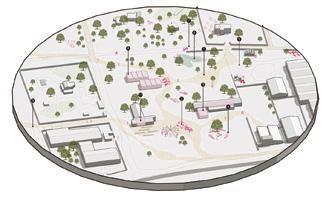

7 — HALMSTAD (SE), WINNER — CONNECTION HUB > SEE MORE P.167
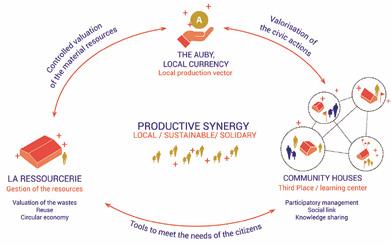
8 — AUBY (FR), RUNNER-UP — PRODUCTIVE SYNERGY > SEE MORE P.157
industrial peak of the area, as a starting point for developing productive activities that could prolong the development of Auby and connect it closely with the canal. The winning project in Selb, Scherben bringen Glück (Shards Bring Good Fortune) (fig. 2), establishes even closer relations with the future development of the site and the skills on-site, as it ties the skills of porcelain making and material sciences as a focal point for developing a new part of Selb with a recognizable identity and mixed-use of production (creative work and living). It also uses New relationships the formal relationship of cross-border bebetween activities create friended cities Selb and new spaces, identities, Aš (Czech Republic) as an interface, which mansynergise existing ifests itself in an annual event at the site. On the activities and generate same site the special mention, Selbstgemacht new ones (fig. 3), uses the knowledge and activity of farming and gardening, and creates, through phytoremediation, a new urban space, revaluating the city around it. The ex aequo runner-up project in Auby, Grey Matter (fig. 4), sees intergenerational living and the redefinition of productive life as an interface of meaningful development in Auby.
9 — CASAR DE CÁCERES (ES), RUNNER-UP — QUESAR DE CÁCERES > SEE MORE P.160
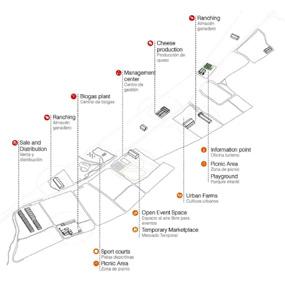
THE INTERFACE OF NETWORKS changes the functioning and relationships in the city and territory by reorganizing or re/establishing networks (traffic, environmental). New relationships between activities create new spaces, identities, synergise existing activities and generate new ones. The winning proposal La Charca de la Abundancia in Casar de Cáceres (fig. 5), takes environment and its boundlessness to dissolve linear networks into a mesh of connections that, through participation and collaboration, mixes landscape, living and industry into a new living environment. It is a similar approach to the special mention proposal, Ithaka (fig. 6) at the same site, where blue and green networks, gradual transformation and local initiatives create informal meshes of different speeds and content. Confronted with completely different conditions, the winning team in Halmstad proposes in the project Connection Hub (fig. 7), a network element that is clearly set out in order to stich diverse parts of the city centre together and strengthens its identity.
THE INTERFACE OF FLOWS —material flows or temporal flows, as in managed and designed processes— performs a process-based solution, dealing either with the process of transformation of artefacts/object/materials (cradle to cradle) or with the processes of the gradual transformation of the
site, which are determined by a set of principles of participation and not by formal goals. The other ex aequo runner-up project in Auby, Productive Synergy (fig. 8), suggests implementing a local currency (flow of money in the community), resource management (flow of material) and community houses (flow of knowledge through sharing of skills and teaching/learning) to ensure the communitybased development. In Casar de Cásares, the runnerup project, Quesar de Cáceres (fig. 9), takes up the material (and knowledge) flow and turns the whole process of the production of cheese —from feed production to animal husbandry, all the way to the final product and waste management— into a generator of new productive spaces that effect the development of the city. Augmented Materials (fig. 10), the runner-up project in Floirac, bases the development of the site on the activities of transforming biobased building materials (reuse, recycling, upcycling) into a local economy which is tightly coupled with skills and craftsmanship (this shows that interfaces are very much interrelated). In Romainville the runner-up proposal, Métropolis métabolisme (fig.11), sees the process of the development of the site – from ecoremediation to local participation and management as the safeguard against gentrification and favouring equitable development.
THE INTERFACE OF FRAMEWORKS focusses a lot of attention on processes of spatial development; it nevertheless does not propose abstract rules, but rather built implementations that ensure the start and direction of a process of re/development without defining a formal or programmatic outcome. Often this framework acts as an identity in generating an entity. This approach is evident in the winning proposal for Rotterdam‘s Brainpark I, Team Brainpark (fig. 12), that sets a robust frame of plot division, with a set of simple principles and well-defined public space (ecologically performative park) that could generate long term focused development of the site. Although it’s close to a masterplan, the proposal is open ended but still ensures clear spatial and programmatic qualities. One of the two special mention projects in Romainville, L.A.B.S [Landscape Active Binding Stripes] (fig. 13) and in

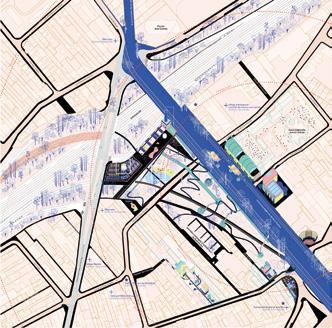
10 — FLOIRAC (FR), RUNNER-UP — AUGMENTED MATERIALS > SEE MORE P.164 11 — ROMAINVILLE (FR), RUNNER-UP — MÉTROPOLIS MÉTABOLISME > SEE MORE P.171
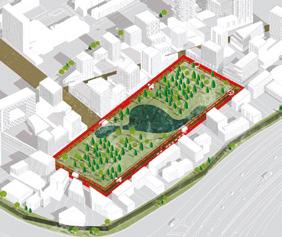
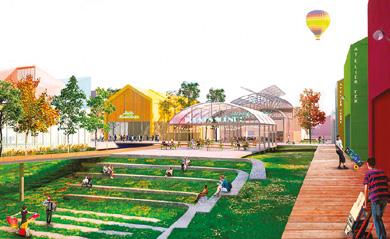
Rotterdam Brainpark I, Elegy for the Office Park (fig. 14), are dealing with very different sites in a similar way, using a precise structure of land development (linear strips originating from Built implementations the existing condition at the location) that that ensure the start and define programmatic and spatial qualities, direction of a process of but allow unplanned relationships re/development without established by the defining a formal or occupants of the sites. The winning proposal programmatic outcome in Floirac, Souys-Lab (fig. 15) , uses the architectural framework of six different scales of implementations and six programmatic roles. They occupy secure diverse development in conjunction with site management, which coordinates them all. In Romainville, such an architectural framework itself is found by the second team special mention, Bridging Productivities (fig. 16), which takes over the structure of the overpass, assigned for demolition, and develops it as a starting point and an identification anchor around (under, upon, besides…) which diverse new uses and buildings are proposed.
The topic “Interface” can be seen as a development device to condense and better understand the possibilities that proposals envisage. Their complexity and thoughtfulness escapes the confines of this singular topic and the approach remains limited. It should hopefully remain valuable in its scope to show what kind of approaches are at our disposal to deal within the topic and with the sites of the productive city that should become liveable, equitable, resourceful, resilient and sustainable.
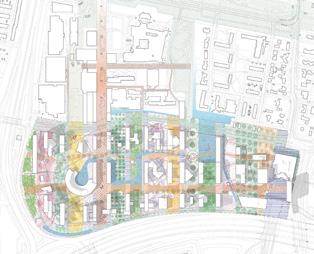
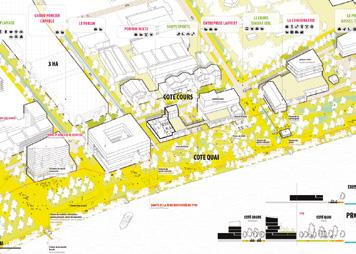
14 — ROTTERDAM BRAINPARK I (NL), SPECIAL MENTION — ELEGY FOR THE OFFICE PARK > SEE MORE P.176 15 — FLOIRAC (FR), WINNER — SOUYS-LAB > SEE MORE P.163
